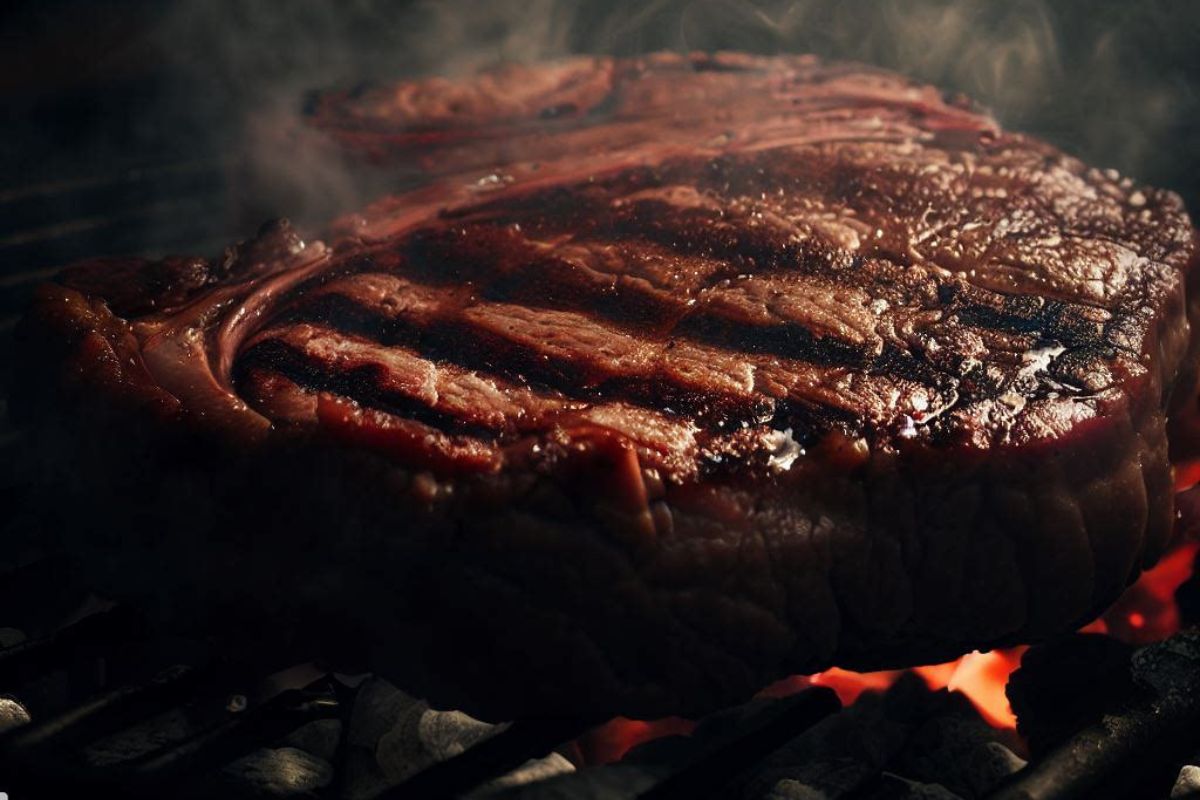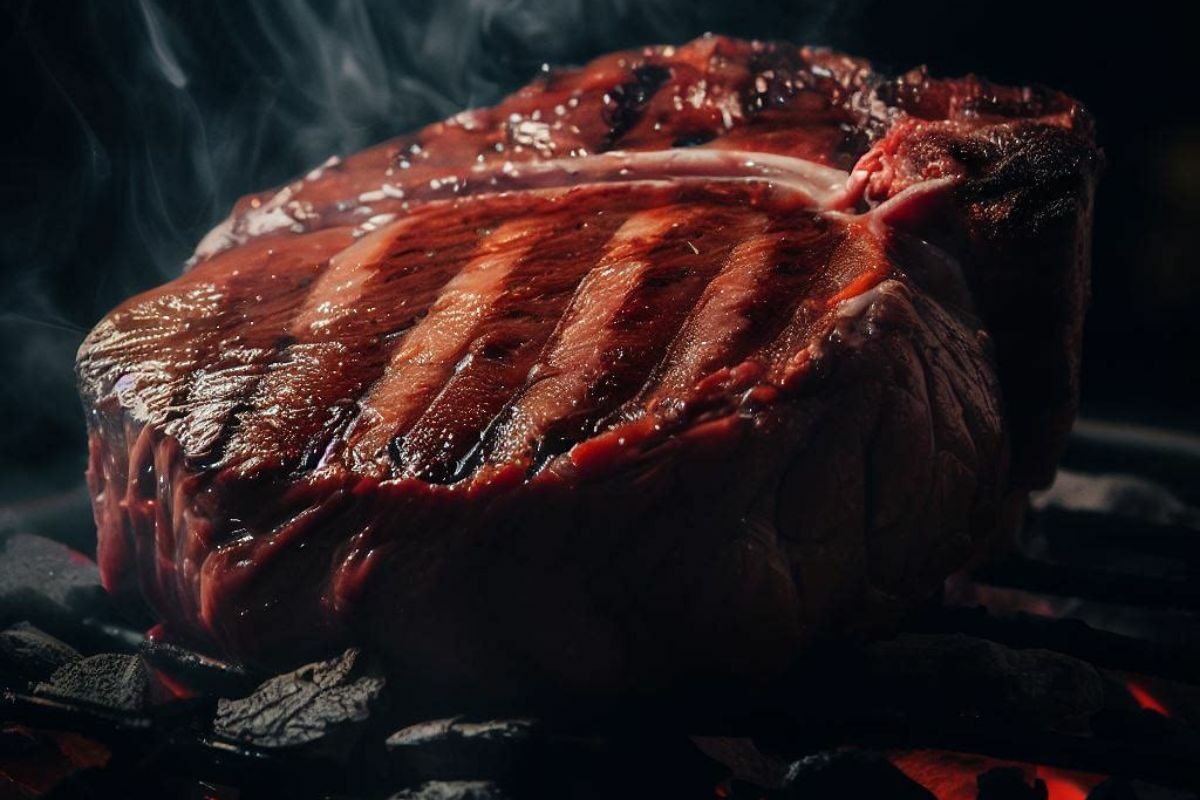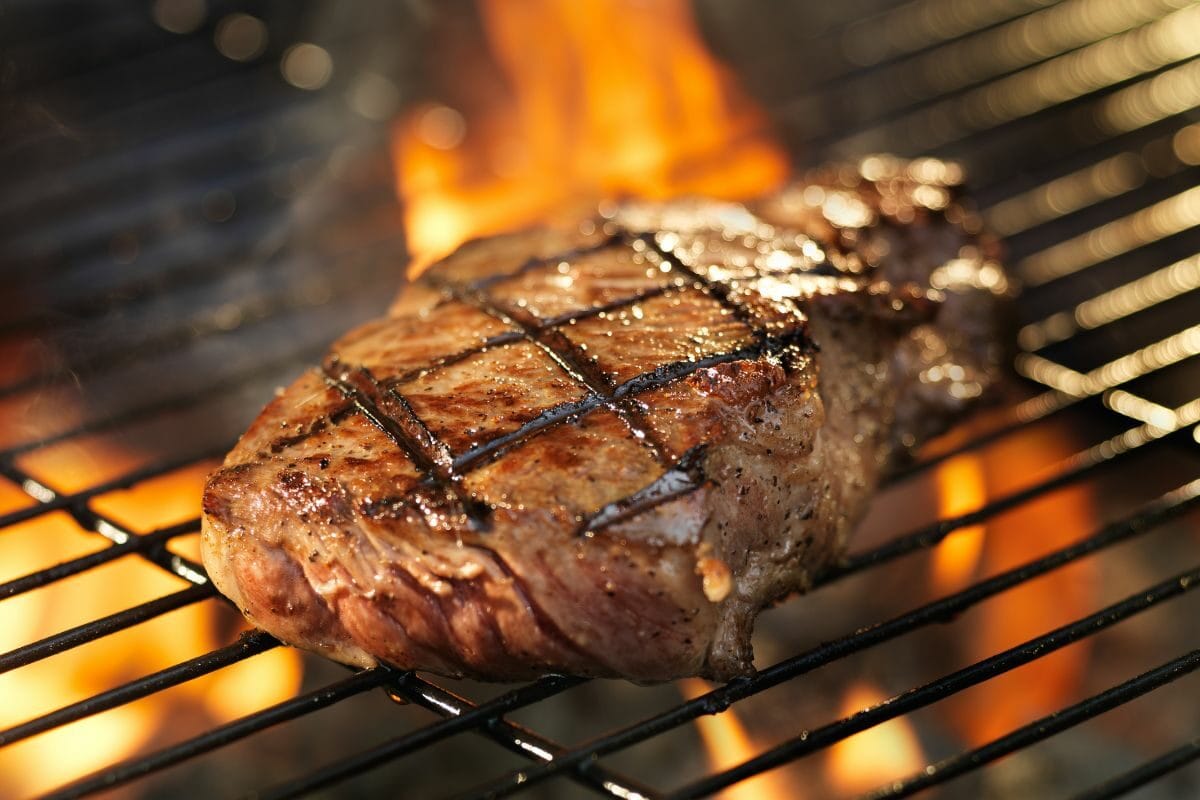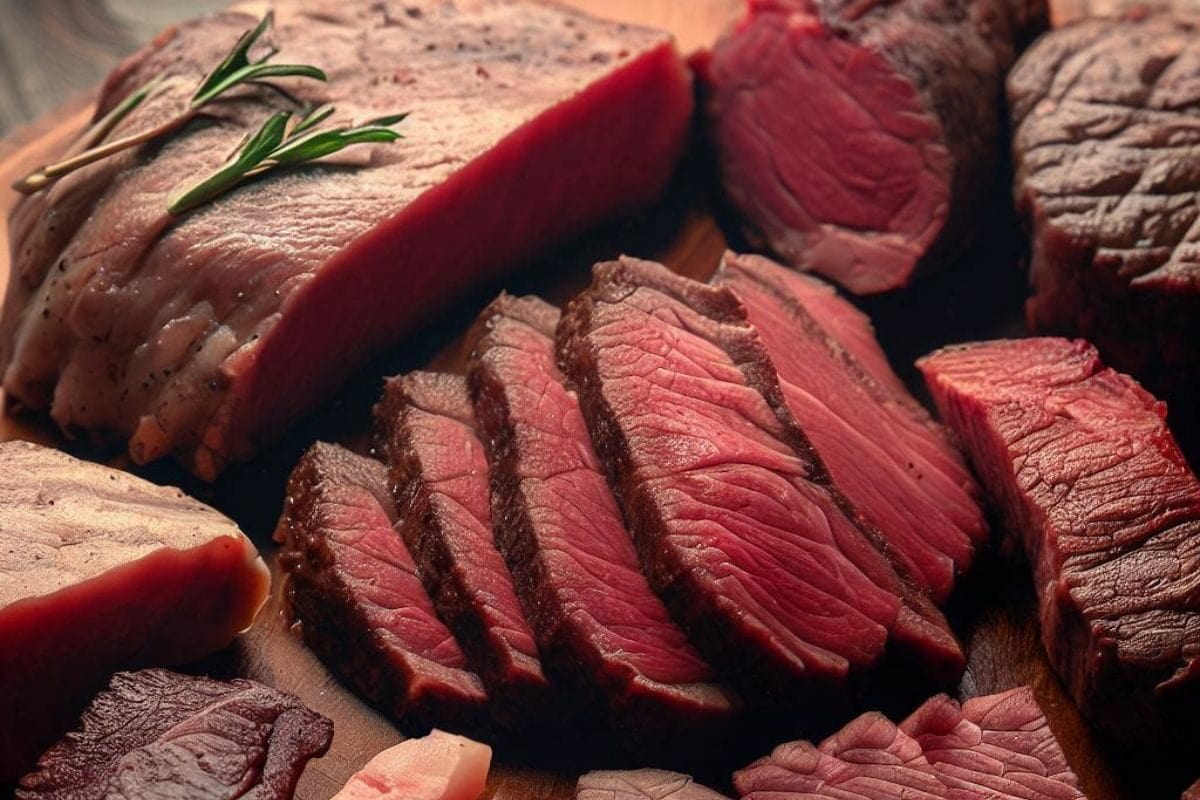The key to cooking steak on a charcoal grill depends on the thickness of the steak – if the steak is thicker than an inch, you should cook it over indirect heat first, and then reverse sear that bad boy. If I’m cooking up skinny steaks (1 inch thick or less), then I get my grill screaming hot and cook that thin cut of beef quickly over the live fire.
I have a huge weakness for grilled steak cooked over a live fire (just ask my cardiologist). If I were to pick out my last meal, it’d be a medium-rare, reverse-seared ribeye with a rosy blush. I’m drooling on my keyboard just thinking about it.
Grilling up a juicy steak is a trick every backyard cook should have in their back pocket. I’m here to get you the details on everything you need to know about grilling steak over charcoal. Fire up your charcoal grill – let’s cook!

If you’re looking to churn out the best steaks possible, it’s critical that you cook thicker steaks with a different method than thin steaks.
Again, if you’re grilling steak that’s thick (around 1 1/2 inch), you should cook them over indirect heat until they’re almost done, then blast them with high heat to sear. Grill a steak that is thin at roaring hot temps the entire time it’s on your charcoal grill.
Your goal when grilling steak should be a dark, mahogany crust that’s well-seared but not burned. To achieve this, along with an internal temperature of 130°F for perfect medium-rare, you’ve got to cook thick and thin steak differently.
Note: The USDA recommends cooking steak to 145°F. While almost all prime steakhouses, chefs, and steak enthusiasts universally agree that medium-rare is the sweet spot for steak deliciousness, there may be an increased risk of foodborne illness at this temperature. This is why restaurants have an asterisk next to cooked-to-order beef, warning consumers of the risk.
More tips for grilling delicious steak – a meat thermometer or instant-read thermometer is your best friend when cooking steak. Make sure you’ve got one ready.
And there’s no need to rest steaks – serve them immediately. Ok, get your charcoal grill ready. It’s time to cook.
Thicker steaks shine when cooked at a lower temperature, then reverse seared at the end of the cook. Look for a premium steak (I’ll cover which cuts to look for in a bit) that is 1 1/2 to 2 inches thick. If the grocery store doesn’t have steaks that thick, ask the butcher to cut them for you.
Ready for a recipe that’ll put other grilled steak recipes to shame? Let’s go!

Makes: 2-4 servings
Time: 2 hours dry brine, 45 minutes to 1 hour to cook on a charcoal grill
Fuel: Charcoal or hardwood lump charcoal
Optional: Oak or hickory wood chips or chunks if you want a smokey flavor
1. Prep the beef. Cut off most of the excess fat from around the steak’s perimeter. Drippings from the fat can cause flare-ups, and the fat doesn’t render. Apply the salt and pepper seasoning at least 1-2 hours before cooking so the steak can dry brine. Coat the entire steak in the rub and stick it back in the refrigerator.
2. Fire up your charcoal grill. Once your chimney is ready, dump the briquettes out and set up your charcoal grill for two cooking zones. The dome thermometer should read around 225°F.
3. Grill steaks. Put the steaks in the indirect heating zone of your charcoal grill. Close the lid. Cook steaks on your charcoal grill until the internal temperature reads 110°F.
A leave-in thermometer makes this simple, but if you don’t have one, check the meat every 10-15 minutes, and more frequently as it gets close to temperature. Remove the steaks from the grill once they hit 110°F.
4. Crank the heat. Open the vents on your charcoal grill and get that baby screaming hot. Add more charcoal if necessary. You can also dump another chimney of briquettes on there if you’re in a hurry. Get your charcoal grill as hot as you can – 500°F at least. 700°F is ideal.
5. Sear the steak. Stick the steaks on the charcoal grill as close to the live fire as possible. Leave the lid open. Rotate the steak 90 degrees (quarter turn) after 30 seconds for beautiful grill marks. Flip the steak after one minute of cooking time, and rotate the other side after 30 seconds.
If you’re a visual learner, the fine folks at Weber posted this handy YouTube video – take a look.
500°F or higher is a sizzling grill. Some long-handled tongs are a handy tool to have. Insulated gloves are another great tool when working over the hot zone.
6. Pull the meat from the charcoal grill at your desired doneness. I pull mine at 125° (they carryover cook to 130°F – perfect medium rare). If your desired temp is different, take the steaks off at that temperature. The exterior should be browned all over.
Pro tip: pull your steaks early – it’s easy to grill them more and impossible to uncook them if they’ve gone past your desired level of doneness.
7. Serve. Serve steaks immediately while still warm. If you let them rest for 5 minutes, the nice crust will soften. Some fancy steakhouses slice the steak for you and serve it on a cutting board. This makes an elegant presentation if desired, though the juices will escape and soften the crust. Add more salt and pepper if the steaks need additional seasoning.
For thin steaks on a charcoal grill, it’s all about cooking them over direct heat at blazing-hot temperatures. To avoid flare-ups or burning the steak, you’ve got to keep them moving. The goal here is the same as with thick steaks – a beautifully dark sear and a pink, medium-rare inside.
Your charcoal grill is the perfect machine for cooking thin steaks, although a gas grill works in a pinch. Some pitmasters even grill thin steaks on a grill grate perched over a half-full chimney at temperatures exceeding 1,000°F – try it sometime!

Makes: 2 servings
Cook time: 10 minutes
Fuel: Charcoal or hardwood lump charcoal
1. Prep the steak: Trim any extra fat and sprinkle with salt. Let the seasoning act as a dry brine. Place the steak in the fridge for 1-2 hours before cooking.
2. Dry the steaks. Pat the steak dry with a folded paper towel. Don’t worry; the salt has worked its way into the steak. Sprinkle with pepper and gently press it in.
3. Fire up your charcoal grill. Get your charcoal grill as hot as you can make it – the coals should almost touch the grill grate. The grates should be set as low as they can go. Use two chimneys of coals if you need to. Dome thermometers usually only register to 700°. You’re aiming for 700°F or even hotter if you want a perfect steak.
I like to set up a cooler side with no coals – these steaks will cook faster than you think. A zone with indirect heat is nice if you need to get a steak off the flames. Here is a great video of how to grill a skinny steak on a hot charcoal grill.
4. Cook the steak. Put the steak on the hottest part of the grill. Again, the direct heat will cook these babies quickly. Leave the lid fully open. Give each side a quarter turn (90 degrees) after cooking for around a minute. Flip after two minutes. The quarter turn will give that steak perfect grill marks. Cook until the internal temperature is 125°F.
Put the steaks on the cooler side of the grill if the flames are getting out of control. Continue cooking once the flames die down. You’re cooking these steaks fast – watch closely so you don’t overcook that delicious hunk of protein.
5. Serve. Time to feast on perfect steak. Stick a pat of butter on top of each steak – the butter will melt slowly, and add more fat to make your steak burst with a decadent flavor. Hey, I said don’t tell your cardiologist about these steaks! Steaks are not a light meal. No need to let these steaks rest – dig in immediately after serving.
Before you can start grilling steak, you’ve got to hit the supermarket and pick out the right type of steak. These cuts of steak are the most expensive because they’re the best – they’re packed with more flavor than cheaper cuts, and they are meltingly tender.
I think rib eye is the king of the steak world, and it’s the preferred cut of beef on the competition circuit. Ribeye is also sold as beauty steak, Scotch fillet, Delmonico steak, market steak, Spencer steak, an entrecôte. It comes from the ribs toward the front end of the cow.
The closer to the steer’s head, the more spinalis muscle there is on a ribeye. The spinalis is the cap of meat on the end of the steak, and it is the most delicious steak on the entire cow. Look for a ribeye with a big cap on it for the best dinner you ever had.
Strip steak (AKA New York strip, Kansas City strip, and top sirloin) comes from the same muscle as the rib eye, the longissimus dorsi, so it’s another excellent option for delicious steak.
Other premium cuts include T-bones (AKA Porterhouse when the tenderloin section is over 1 1/2 inches wide), which contain both strip and tenderloin.
The most tender steaks come from the tenderloin like the filet mignon and chateaubriand.
Looking for a more affordable cut of steak? You can grill a delicious steak using sirloin, flank, round, and others, but these cuts of beef are not as tender as the premium options.

Almost as important as the cut of steak you go with is the grade of steak you can get your hands on. USDA Prime is the highest grade (3% of all beef sold in America), followed by USDA Choice, then USDA Select.
The new kid on the beef block is American Wagyu, which is Japanese Wagyu (a breed of cow) crossbred with traditional American cattle. It’s rich in fat and intensely flavorful. Your supermarket may or may not have Wagyu – mine does, and I enjoy occasionally splurging on it. Waygu makes a special main course you’ll never forget. It is also available via online sellers.
Prime Grade beef is what’s sold in expensive steakhouses. USDA Prime is riddled with rich marbling and is perfectly fatty.
Unfortunately, since so few cattle qualify as USDA Prime grade, acquiring the beef can be difficult. You won’t find USDA Prime cuts of steak at most grocery stores. If you manage to find some, pounce on it – you’ll be happy you did. If you’re feeding a crowd, you’re sure to impress your guests.
If you’re on a budget, you can grill a quality steak on your charcoal grill with a USDA Select piece of beef. Follow my recipes, and people will run to your place for steak night. I’ve found that the best way to score good beef is to befriend a butcher – shop around, tell them you’ve got a nice dinner and want the nicest cut they can find.
I prefer to let the steak flavor shine through by keeping the seasoning simple – ideally, only salt and pepper are used. That way, the beef and firey grill flavors are center stage.
But you are free to use your favorite BBQ rub, Lawry’s Seasoned Salt, or whatever you love. I’d urge you to stay away from any recipes that have you marinating the meat if it’s a premium cut.
There you have it, everything you need to know to grill steaks that are so tasty, you’ll wish you could have them every night of the week. Steak and charcoal grills are a perfect match, like macaroni and cheese.
Remember, the key to grilling steak on a charcoal grill is to cook wide steaks over indirect heat until they hit 110°F, and to finish them by searing over high, direct heat.
For thin steaks, crank that charcoal grill up to a scorching temperature, and toss the steaks on there. Flip them quickly, and monitor the grill – the juices from the steaks can drip down and make some big flames. Prepare yourself. Ok, the wait is over – time to get grilling!